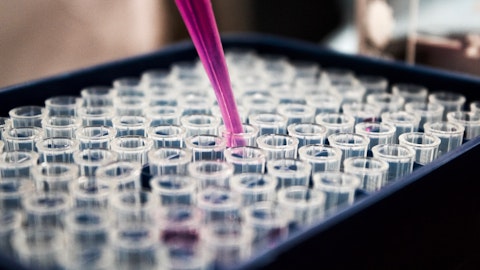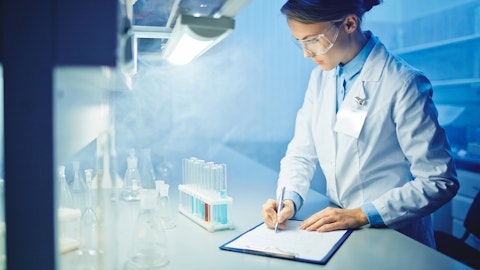Joe Pantginis : Hi, good morning, everybody. Thanks to taking my question. Two questions please. So, first for 0101, wanted to ask about currently what you have ready to go followed by your intermediate near term needs and intermediate needs with regard to manufacturing? And then the second question is a little bit of the off the beaten path here. Because it’s been nice to hear such the encouraging data updates from a 0101, but I wanted to ask about 0202 and the universal flu vaccine. You are sitting on what we consider to be a very strong asset profile and the data that you’ve accumulated to date. So other than the rhetorical answer of financial resources, what could you envision being a development plan for that asset? Thanks.
Frank Bedu-Addo: Hey, thanks a lot Joe. I’ll start with the first question in terms of what we have ready to go with PDS0101. So, with PDS0101, we have done all the tech transfer. The material has been scaled up to our commercial process, and the Phase III clinical product has already been successfully manufactured and released. So, in terms of clinical product that has been scaled up to the final process and has been successfully manufactured, we are there today. So, the material is ready to go. We don’t have any additional needs from the perspective of PDS0101 materials in order to run the phase — to run the Phase III clinical trial with either program VERSATILE-002 or the triple combination. With PDS0202, as you mentioned, this is a program that we are quite excited about.
Today, our resources, financial resources are really focused on the oncology programs. However, we have made significant progress also with this program. As you know, the data was presented in September at the European influenza Conference. The data from ferrets, right? Ferrets being the gold standard for preclinical studies. So, it was very important to be able to demonstrate that we can replicate the data that was generated in the mouse models in the ferrets, which are closest to humans in influenza. And again, all that was done has been done successfully. We’ve shown very similar levels or identical levels of broadly reactive neutralizing antibodies against multiple strains of the flu that was shown successfully in Ferrets. We also showed successful prevention of viral replication in the lungs when the animals were given lethal doses of the H1 N1 virus, as well as protection against infection in the ferrets also.
So, we have shown very good translation. Now, from PDS perspective, for us, this is not surprising because again, even in our oncology products, we’ve shown very good translation from preclinical models to human right. And so, we expected this. The NIAID is extremely encouraged by the data that they’ve seen today. And so, we have had some discussions. We are still hopeful that we will get some notification sooner or later regarding the next steps. What we would envision or what we would like to see would be for this to go into at least a Phase I Phase II human clinical trial sometime next year, and start generating the human data that can also replicate the kinds of broadly reactive neutralizing antibodies that we’re seeing in the animal models in humans, hopefully give — provide very important data on safety.
As you know, with preventive vaccine safety is extremely important. We’ve seen very good safety profile today with PDS0101. So, we do expect to see very similar safety with the preventive vaccine. And then hopefully, depending on when in the year it’s done, get some data on actual prevention against infection with the flu. So, we are really hopeful. We still are very good discussions with NIAID. They’ve indicated that this is something they would like to move forward, and so we are waiting to learn what the next steps will be and when those next steps will start.
Operator: [Operator Instructions]. Our next question comes from the line of Jim Molloy with Alliance Resource Partners. Please proceed with your question.
Laura Suriel: Hello, this is Laura on for Jim. Thank you for taking the questions and congrats on all your progress. So, you mentioned an upcoming trial for your preclinical PDS0103 candidate for the first half of next year. What are any other updates that you have for your preclinical PDS0102 and 0104 candidates?
Frank Bedu-Addo: Hi, Laura. Thanks for the question. So, with PDS0103, as I mentioned, the goal is to start in the third quarter — in the first half of next year, and so that is going to be done under our collaboration with the NIH. Right now, we are finalizing the CMC section. We are finalizing the animal studies and looking at the new triple combination, which is potentially going to be very likely the path we go down. That’s been evaluated now in specific tumor models that we would want to include in the IND filing. So, we are working towards an IND filing hopefully in Q1 of next year to get this into the clinic, hopefully by the second quarter of next year. With PDS0102, we are also working now on the tech transfer, and the formulation development has been completed.
Preclinical work has been completed with PDS0102. And just to remind, just to remind the audience who may still be on PDS0102 specifically addressing prostate cancer. So, I’m sure you can see how that potentially lines up with what we are doing with docetaxel. There is the potential that we could include that to make a new triple combination. But the goal here with that program is to get that dual combination as rapidly as possible to commercialization, but there’s potential for expansion in terms of even more difficult or latest treat cancer patients and decline of circulating tumor DNA using that PDS0102 asset in which the target is top, TARP. TARP has been found in about 90% of prostate cancers at all stages of the disease and about 50% of breast cancers.




